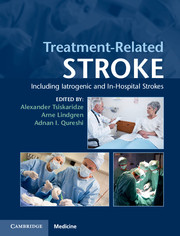Book contents
- Treatment-Related StrokeIncluding Iatrogenic and In-hospital Strokes
- Treatment-Related Stroke
- Copyright page
- Dedication
- Contents
- Contributors
- Preface
- Section I Iatrogenic ischemic strokes: peri- and postoperative strokes
- Section II Iatrogenic ischemic strokes: stroke after endovascular procedures
- Section III Iatrogenic ischemic strokes: other causes
- Section IV Iatrogenic hemorrhagic strokes: thrombolysis-related hemorrhagic strokes
- Section V Iatrogenic hemorrhagic strokes: intracranial bleeding
- Section VI Iatrogenic hemorrhagic strokes: anticoagulation-related intracranial hemorrhage
- Section VII Other uncommon causes of iatrogenic stroke
- Section VIII Cerebral venous thrombosis
- Section IX Medication reversal and restarting in patients with iatrogenic strokes
- Index
- References
Section VII - Other uncommon causes of iatrogenic stroke
Published online by Cambridge University Press: 20 October 2016
- Treatment-Related StrokeIncluding Iatrogenic and In-hospital Strokes
- Treatment-Related Stroke
- Copyright page
- Dedication
- Contents
- Contributors
- Preface
- Section I Iatrogenic ischemic strokes: peri- and postoperative strokes
- Section II Iatrogenic ischemic strokes: stroke after endovascular procedures
- Section III Iatrogenic ischemic strokes: other causes
- Section IV Iatrogenic hemorrhagic strokes: thrombolysis-related hemorrhagic strokes
- Section V Iatrogenic hemorrhagic strokes: intracranial bleeding
- Section VI Iatrogenic hemorrhagic strokes: anticoagulation-related intracranial hemorrhage
- Section VII Other uncommon causes of iatrogenic stroke
- Section VIII Cerebral venous thrombosis
- Section IX Medication reversal and restarting in patients with iatrogenic strokes
- Index
- References
- Type
- Chapter
- Information
- Treatment-Related StrokeIncluding Iatrogenic and In-Hospital Strokes, pp. 203 - 240Publisher: Cambridge University PressPrint publication year: 2016



